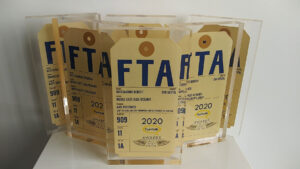LAST CHANCE: Who Will Be The Next FlyerTalk Member To Fly Free To Amsterdam?
FlyerTalk Evangelist
Join Date: Jan 2006
Location: A menace to everything in the sky. Yes. Even birds.
Programs: Eh+ Rapid Rolleyes
Posts: 14,520
I want stroop waffel!
FlyerTalk Evangelist
Join Date: Feb 2006
Location: A festering pit; a pustule of a fistula set athwart the miasmic swamps of the armpit of the Gulf of Mexico - a Godforsaken wart upon a dark crevasse of the World. (IAH)
Programs: UA Lifetime Gold, BA Silver, Marriott Lifetime Plat, Hilton Gold, Accor Gold
Posts: 31,403
It's technically possible to make 2,880 posts per day. A truly determined Post Whore could easily bust this sucker wide-open.
� 198. Expensing of environmental remediation costs
How Current is This?
(a) In general
A taxpayer may elect to treat any qualified environmental remediation expenditure which is paid or incurred by the taxpayer as an expense which is not chargeable to capital account. Any expenditure which is so treated shall be allowed as a deduction for the taxable year in which it is paid or incurred.
(b) Qualified environmental remediation expenditure
For purposes of this section�
(1) In general
The term �qualified environmental remediation expenditure� means any expenditure�
(A) which is otherwise chargeable to capital account, and
(B) which is paid or incurred in connection with the abatement or control of hazardous substances at a qualified contaminated site.
(2) Special rule for expenditures for depreciable property
Such term shall not include any expenditure for the acquisition of property of a character subject to the allowance for depreciation which is used in connection with the abatement or control of hazardous substances at a qualified contaminated site; except that the portion of the allowance under section 167 for such property which is otherwise allocated to such site shall be treated as a qualified environmental remediation expenditure.
(c) Qualified contaminated site
For purposes of this section�
(1) In general
The term �qualified contaminated site� means any area�
(A) which is held by the taxpayer for use in a trade or business or for the production of income, or which is property described in section 1221 (a)(1) in the hands of the taxpayer, and
(B) at or on which there has been a release (or threat of release) or disposal of any hazardous substance.
(2) National priorities listed sites not included
Such term shall not include any site which is on, or proposed for, the national priorities list under section 105(a)(8)(B) of the Comprehensive Environmental Response, Compensation, and Liability Act of 1980 (as in effect on the date of the enactment of this section).
(3) Taxpayer must receive statement from State environmental agency
An area shall be treated as a qualified contaminated site with respect to expenditures paid or incurred during any taxable year only if the taxpayer receives a statement from the appropriate agency of the State in which such area is located that such area meets the requirement of paragraph (1)(B).
(4) Appropriate State agency
For purposes of paragraph (3), the chief executive officer of each State may, in consultation with the Administrator of the Environmental Protection Agency, designate the appropriate State environmental agency within 60 days of the date of the enactment of this section. If the chief executive officer of a State has not designated an appropriate environmental agency within such 60-day period, the appropriate environmental agency for such State shall be designated by the Administrator of the Environmental Protection Agency.
(d) Hazardous substance
For purposes of this section�
(1) In general
The term �hazardous substance� means�
(A) any substance which is a hazardous substance as defined in section 101(14) of the Comprehensive Environmental Response, Compensation, and Liability Act of 1980,
(B) any substance which is designated as a hazardous substance under section 102 of such Act, and
(C) any petroleum product (as defined in section 4612 (a)(3)).
(2) Exception
Such term shall not include any substance with respect to which a removal or remedial action is not permitted under section 104 of such Act by reason of subsection (a)(3) thereof.
(e) Deduction recaptured as ordinary income on sale, etc.
Solely for purposes of section 1245, in the case of property to which a qualified environmental remediation expenditure would have been capitalized but for this section�
(1) the deduction allowed by this section for such expenditure shall be treated as a deduction for depreciation, and
(2) such property (if not otherwise section 1245 property) shall be treated as section 1245 property solely for purposes of applying section 1245 to such deduction.
(f) Coordination with other provisions
Sections 280B and 468 shall not apply to amounts which are treated as expenses under this section.
(g) Regulations
The Secretary shall prescribe such regulations as may be necessary or appropriate to carry out the purposes of this section.
(h) Termination
This section shall not apply to expenditures paid or incurred after December 31, 2007.
� 198. Expensing of environmental remediation costs
How Current is This?
(a) In general
A taxpayer may elect to treat any qualified environmental remediation expenditure which is paid or incurred by the taxpayer as an expense which is not chargeable to capital account. Any expenditure which is so treated shall be allowed as a deduction for the taxable year in which it is paid or incurred.
(b) Qualified environmental remediation expenditure
For purposes of this section�
(1) In general
The term �qualified environmental remediation expenditure� means any expenditure�
(A) which is otherwise chargeable to capital account, and
(B) which is paid or incurred in connection with the abatement or control of hazardous substances at a qualified contaminated site.
(2) Special rule for expenditures for depreciable property
Such term shall not include any expenditure for the acquisition of property of a character subject to the allowance for depreciation which is used in connection with the abatement or control of hazardous substances at a qualified contaminated site; except that the portion of the allowance under section 167 for such property which is otherwise allocated to such site shall be treated as a qualified environmental remediation expenditure.
(c) Qualified contaminated site
For purposes of this section�
(1) In general
The term �qualified contaminated site� means any area�
(A) which is held by the taxpayer for use in a trade or business or for the production of income, or which is property described in section 1221 (a)(1) in the hands of the taxpayer, and
(B) at or on which there has been a release (or threat of release) or disposal of any hazardous substance.
(2) National priorities listed sites not included
Such term shall not include any site which is on, or proposed for, the national priorities list under section 105(a)(8)(B) of the Comprehensive Environmental Response, Compensation, and Liability Act of 1980 (as in effect on the date of the enactment of this section).
(3) Taxpayer must receive statement from State environmental agency
An area shall be treated as a qualified contaminated site with respect to expenditures paid or incurred during any taxable year only if the taxpayer receives a statement from the appropriate agency of the State in which such area is located that such area meets the requirement of paragraph (1)(B).
(4) Appropriate State agency
For purposes of paragraph (3), the chief executive officer of each State may, in consultation with the Administrator of the Environmental Protection Agency, designate the appropriate State environmental agency within 60 days of the date of the enactment of this section. If the chief executive officer of a State has not designated an appropriate environmental agency within such 60-day period, the appropriate environmental agency for such State shall be designated by the Administrator of the Environmental Protection Agency.
(d) Hazardous substance
For purposes of this section�
(1) In general
The term �hazardous substance� means�
(A) any substance which is a hazardous substance as defined in section 101(14) of the Comprehensive Environmental Response, Compensation, and Liability Act of 1980,
(B) any substance which is designated as a hazardous substance under section 102 of such Act, and
(C) any petroleum product (as defined in section 4612 (a)(3)).
(2) Exception
Such term shall not include any substance with respect to which a removal or remedial action is not permitted under section 104 of such Act by reason of subsection (a)(3) thereof.
(e) Deduction recaptured as ordinary income on sale, etc.
Solely for purposes of section 1245, in the case of property to which a qualified environmental remediation expenditure would have been capitalized but for this section�
(1) the deduction allowed by this section for such expenditure shall be treated as a deduction for depreciation, and
(2) such property (if not otherwise section 1245 property) shall be treated as section 1245 property solely for purposes of applying section 1245 to such deduction.
(f) Coordination with other provisions
Sections 280B and 468 shall not apply to amounts which are treated as expenses under this section.
(g) Regulations
The Secretary shall prescribe such regulations as may be necessary or appropriate to carry out the purposes of this section.
(h) Termination
This section shall not apply to expenditures paid or incurred after December 31, 2007.
FlyerTalk Evangelist
Join Date: Aug 2005
Location: 40� 41' 45" N - 74� 10' 18" W
Programs: UALCO Holdings General Member
Posts: 18,784
Detroit Michigan Is in the Eastern Time Zone
Please Check the clocks
Please Check the clocks
Join Date: Apr 2002
Location: The sky is my home
Programs: Concorde Mach 2 -UAMM- First to Fly A380/B787/B747-8i/FlyingHonu
Posts: 3,035
A he nani Kaua`i `ea
`O ku`u `�ina
Ke one Nohili `ea
E kani mai nei
Ka wai `anapanapa `ea
I ke kula o M�n�
`O ke kaupoku hale `ea
Lau a`o Limaloa
A he nani H�`upu `ea
Ka ua noe o Koloa
A he nani Lihu`e `ea
I ka ua P�`upili
A he nani Hanalei `ea
I ka wai o Namolokama
A he nani Ha`ena `ea
I na pali `o ahi
A he nani Kalalau `ea
Na pali o Ko`olau
Ha`ina ka puana `ea
A he nani Kaua`i
`O ku`u `�ina
Ke one Nohili `ea
E kani mai nei
Ka wai `anapanapa `ea
I ke kula o M�n�
`O ke kaupoku hale `ea
Lau a`o Limaloa
A he nani H�`upu `ea
Ka ua noe o Koloa
A he nani Lihu`e `ea
I ka ua P�`upili
A he nani Hanalei `ea
I ka wai o Namolokama
A he nani Ha`ena `ea
I na pali `o ahi
A he nani Kalalau `ea
Na pali o Ko`olau
Ha`ina ka puana `ea
A he nani Kaua`i
Join Date: Dec 2006
Location: ORD
Programs: AA EXP & million miler
Posts: 3,992
B post
Original Member, Moderator: Hotel Deals and MilesBuzz




Join Date: May 1998
Location: Washington, DC
Posts: 14,267

Join Date: May 2004
Location: SFO sometimes
Programs: UA 1K, AA gold, A3 gold
Posts: 1,634
Let's do a weekend in AMS!
Join Date: Jul 2007
Location: NJ
Programs: CO Plat, Amex Plat
Posts: 144
FlyerTalk Evangelist
Join Date: Feb 2006
Location: A festering pit; a pustule of a fistula set athwart the miasmic swamps of the armpit of the Gulf of Mexico - a Godforsaken wart upon a dark crevasse of the World. (IAH)
Programs: UA Lifetime Gold, BA Silver, Marriott Lifetime Plat, Hilton Gold, Accor Gold
Posts: 31,403
I've only been averaging about 750 posts/day 
� 199. Income attributable to domestic production activities
How Current is This?
(a) Allowance of deduction
(1) In general
There shall be allowed as a deduction an amount equal to 9 percent of the lesser of�
(A) the qualified production activities income of the taxpayer for the taxable year, or
(B) taxable income (determined without regard to this section) for the taxable year.
(2) Phasein
In the case of any taxable year beginning after 2004 and before 2010, paragraph (1) shall be applied by substituting for the percentage contained therein the transition percentage determined under the following table:
For taxable years The transition beginning in: percentage is: 2005 or 2006 3 2007, 2008, or 2009 6.
(b) Deduction limited to wages paid
(1) In general
The amount of the deduction allowable under subsection (a) for any taxable year shall not exceed 50 percent of the W�2 wages of the taxpayer for the taxable year.
(2) W-2 wages
For purposes of this section�
(A) In general
The term �W-2 wages� means, with respect to any person for any taxable year of such person, the sum of the amounts described in paragraphs (3) and (8) of section 6051 (a) paid by such person with respect to employment of employees by such person during the calendar year ending during such taxable year.
(B) Limitation to wages attributable to domestic production
Such term shall not include any amount which is not properly allocable to domestic production gross receipts for purposes of subsection (c)(1).
(C) Return requirement
Such term shall not include any amount which is not properly included in a return filed with the Social Security Administration on or before the 60th day after the due date (including extensions) for such return.
(3) Acquisitions and dispositions
The Secretary shall provide for the application of this subsection in cases where the taxpayer acquires, or disposes of, the major portion of a trade or business or the major portion of a separate unit of a trade or business during the taxable year.
(c) Qualified production activities income
For purposes of this section�
(1) In general
The term �qualified production activities income� for any taxable year means an amount equal to the excess (if any) of�
(A) the taxpayer�s domestic production gross receipts for such taxable year, over
(B) the sum of�
(i) the cost of goods sold that are allocable to such receipts, and
(ii) other expenses, losses, or deductions (other than the deduction allowed under this section), which are properly allocable to such receipts.
(2) Allocation method
The Secretary shall prescribe rules for the proper allocation of items described in paragraph (1) for purposes of determining qualified production activities income. Such rules shall provide for the proper allocation of items whether or not such items are directly allocable to domestic production gross receipts.
(3) Special rules for determining costs
(A) In general
For purposes of determining costs under clause (i) of paragraph (1)(B), any item or service brought into the United States shall be treated as acquired by purchase, and its cost shall be treated as not less than its value immediately after it entered the United States. A similar rule shall apply in determining the adjusted basis of leased or rented property where the lease or rental gives rise to domestic production gross receipts.
(B) Exports for further manufacture
In the case of any property described in subparagraph (A) that had been exported by the taxpayer for further manufacture, the increase in cost or adjusted basis under subparagraph (A) shall not exceed the difference between the value of the property when exported and the value of the property when brought back into the United States after the further manufacture.
(4) Domestic production gross receipts
(A) In general
The term �domestic production gross receipts� means the gross receipts of the taxpayer which are derived from�
(i) any lease, rental, license, sale, exchange, or other disposition of�
(I) qualifying production property which was manufactured, produced, grown, or extracted by the taxpayer in whole or in significant part within the United States,
(II) any qualified film produced by the taxpayer, or
(III) electricity, natural gas, or potable water produced by the taxpayer in the United States,
(ii) in the case of a taxpayer engaged in the active conduct of a construction trade or business, construction of real property performed in the United States by the taxpayer in the ordinary course of such trade or business, or
(iii) in the case of a taxpayer engaged in the active conduct of an engineering or architectural services trade or business, engineering or architectural services performed in the United States by the taxpayer in the ordinary course of such trade or business with respect to the construction of real property in the United States.
(B) Exceptions
Such term shall not include gross receipts of the taxpayer which are derived from�
(i) the sale of food and beverages prepared by the taxpayer at a retail establishment,
(ii) the transmission or distribution of electricity, natural gas, or potable water, or
(iii) the lease, rental, license, sale, exchange, or other disposition of land.
(C) Special rule for certain Government contracts
Gross receipts derived from the manufacture or production of any property described in subparagraph (A)(i)(I) shall be treated as meeting the requirements of subparagraph (A)(i) if�
(i) such property is manufactured or produced by the taxpayer pursuant to a contract with the Federal Government, and
(ii) the Federal Acquisition Regulation requires that title or risk of loss with respect to such property be transferred to the Federal Government before the manufacture or production of such property is complete.
(D) Partnerships owned by expanded affiliated groups
For purposes of this paragraph, if all of the interests in the capital and profits of a partnership are owned by members of a single expanded affiliated group at all times during the taxable year of such partnership, the partnership and all members of such group shall be treated as a single taxpayer during such period.
(5) Qualifying production property
The term �qualifying production property� means�
(A) tangible personal property,
(B) any computer software, and
(C) any property described in section 168 (f)(4).
(6) Qualified film
The term �qualified film� means any property described in section 168 (f)(3) if not less than 50 percent of the total compensation relating to the production of such property is compensation for services performed in the United States by actors, production personnel, directors, and producers. Such term does not include property with respect to which records are required to be maintained under section 2257 of title 18, United States Code.
(7) Related persons
(A) In general
The term �domestic production gross receipts� shall not include any gross receipts of the taxpayer derived from property leased, licensed, or rented by the taxpayer for use by any related person.
(B) Related person
For purposes of subparagraph (A), a person shall be treated as related to another person if such persons are treated as a single employer under subsection (a) or (b) of section 52 or subsection (m) or (o) of section 414, except that determinations under subsections (a) and (b) of section 52 shall be made without regard to section 1563 (b).
(d) Definitions and special rules
(1) Application of section to pass-thru entities
(A) Partnerships and S corporations
In the case of a partnership or S corporation�
(i) this section shall be applied at the partner or shareholder level,
(ii) each partner or shareholder shall take into account such person�s allocable share of each item described in subparagraph (A) or (B) of subsection (c)(1) (determined without regard to whether the items described in such subparagraph (A) exceed the items described in such subparagraph (B)), and
(iii) each partner or shareholder shall be treated for purposes of subsection (b) as having W-2 wages for the taxable year in an amount equal to such person�s allocable share of the W-2 wages of the partnership or S corporation for the taxable year (as determined under regulations prescribed by the Secretary).
(B) Trusts and estates
In the case of a trust or estate�
(i) the items referred to in subparagraph (A)(ii) (as determined therein) and the W�2 wages of the trust or estate for the taxable year, shall be apportioned between the beneficiaries and the fiduciary (and among the beneficiaries) under regulations prescribed by the Secretary, and
(ii) for purposes of paragraph (2), adjusted gross income of the trust or estate shall be determined as provided in section 67 (e) with the adjustments described in such paragraph.
(C) Regulations
The Secretary may prescribe rules requiring or restricting the allocation of items and wages under this paragraph and may prescribe such reporting requirements as the Secretary determines appropriate.
(2) Application to individuals
In the case of an individual, subsection (a)(1)(B) shall be applied by substituting �adjusted gross income� for �taxable income�. For purposes of the preceding sentence, adjusted gross income shall be determined�
(A) after application of sections 86, 135, 137, 219, 221, 222, and 469, and
(B) without regard to this section.
(3) Agricultural and horticultural cooperatives
(A) Deduction allowed to patrons
Any person who receives a qualified payment from a specified agricultural or horticultural cooperative shall be allowed for the taxable year in which such payment is received a deduction under subsection (a) equal to the portion of the deduction allowed under subsection (a) to such cooperative which is�
(i) allowed with respect to the portion of the qualified production activities income to which such payment is attributable, and
(ii) identified by such cooperative in a written notice mailed to such person during the payment period described in section 1382 (d).
(B) Cooperative denied deduction for portion of qualified payments
The taxable income of a specified agricultural or horticultural cooperative shall not be reduced under section 1382 by reason of that portion of any qualified payment as does not exceed the deduction allowable under subparagraph (A) with respect to such payment.
(C) Taxable income of cooperatives determined without regard to certain deductions
For purposes of this section, the taxable income of a specified agricultural or horticultural cooperative shall be computed without regard to any deduction allowable under subsection (b) or (c) of section 1382 (relating to patronage dividends, per-unit retain allocations, and nonpatronage distributions).
(D) Special rule for marketing cooperatives
For purposes of this section, a specified agricultural or horticultural cooperative described in subparagraph (F)(ii) shall be treated as having manufactured, produced, grown, or extracted in whole or significant part any qualifying production property marketed by the organization which its patrons have so manufactured, produced, grown, or extracted.
(E) Qualified payment
For purposes of this paragraph, the term �qualified payment� means, with respect to any person, any amount which�
(i) is described in paragraph (1) or (3) of section 1385 (a),
(ii) is received by such person from a specified agricultural or horticultural cooperative, and
(iii) is attributable to qualified production activities income with respect to which a deduction is allowed to such cooperative under subsection (a).
(F) Specified agricultural or horticultural cooperative
For purposes of this paragraph, the term �specified agricultural or horticultural cooperative� means an organization to which part I of subchapter T applies which is engaged�
(i) in the manufacturing, production, growth, or extraction in whole or significant part of any agricultural or horticultural product, or
(ii) in the marketing of agricultural or horticultural products.
(4) Special rule for affiliated groups
(A) In general
All members of an expanded affiliated group shall be treated as a single corporation for purposes of this section.
(B) Expanded affiliated group
For purposes of this section, the term �expanded affiliated group� means an affiliated group as defined in section 1504 (a), determined�
(i) by substituting �more than 50 percent� for �at least 80 percent� each place it appears, and
(ii) without regard to paragraphs (2) and (4) of section 1504 (b).
(C) Allocation of deduction
Except as provided in regulations, the deduction under subsection (a) shall be allocated among the members of the expanded affiliated group in proportion to each member�s respective amount (if any) of qualified production activities income.
(5) Trade or business requirement
This section shall be applied by only taking into account items which are attributable to the actual conduct of a trade or business.
(6) Coordination with minimum tax
For purposes of determining alternative minimum taxable income under section 55�
(A) qualified production activities income shall be determined without regard to any adjustments under sections 56 through 59, and
(B) in the case of a corporation, subsection (a)(1)(B) shall be applied by substituting �alternative minimum taxable income� for �taxable income�.
(7) Unrelated business taxable income
For purposes of determining the tax imposed by section 511, subsection (a)(1)(B) shall be applied by substituting �unrelated business taxable income� for �taxable income�.
(8) Treatment of activities in Puerto Rico
(A) In general
In the case of any taxpayer with gross receipts for any taxable year from sources within the Commonwealth of Puerto Rico, if all of such receipts are taxable under section 1 or 11 for such taxable year, then for purposes of determining the domestic production gross receipts of such taxpayer for such taxable year under subsection (c)(4), the term �United States� shall include the Commonwealth of Puerto Rico.
(B) Special rule for applying wage limitation
In the case of any taxpayer described in subparagraph (A), for purposes of applying the limitation under subsection (b) for any taxable year, the determination of W�2 wages of such taxpayer shall be made without regard to any exclusion under section 3401 (a)(8) for remuneration paid for services performed in Puerto Rico.
(C) Termination
This paragraph shall apply only with respect to the first 2 taxable years of the taxpayer beginning after December 31, 2005, and before January 1, 2008.
(9) Regulations
The Secretary shall prescribe such regulations as are necessary to carry out the purposes of this section, including regulations which prevent more than 1 taxpayer from being allowed a deduction under this section with respect to any activity described in subsection (c)(4)(A)(i).

� 199. Income attributable to domestic production activities
How Current is This?
(a) Allowance of deduction
(1) In general
There shall be allowed as a deduction an amount equal to 9 percent of the lesser of�
(A) the qualified production activities income of the taxpayer for the taxable year, or
(B) taxable income (determined without regard to this section) for the taxable year.
(2) Phasein
In the case of any taxable year beginning after 2004 and before 2010, paragraph (1) shall be applied by substituting for the percentage contained therein the transition percentage determined under the following table:
For taxable years The transition beginning in: percentage is: 2005 or 2006 3 2007, 2008, or 2009 6.
(b) Deduction limited to wages paid
(1) In general
The amount of the deduction allowable under subsection (a) for any taxable year shall not exceed 50 percent of the W�2 wages of the taxpayer for the taxable year.
(2) W-2 wages
For purposes of this section�
(A) In general
The term �W-2 wages� means, with respect to any person for any taxable year of such person, the sum of the amounts described in paragraphs (3) and (8) of section 6051 (a) paid by such person with respect to employment of employees by such person during the calendar year ending during such taxable year.
(B) Limitation to wages attributable to domestic production
Such term shall not include any amount which is not properly allocable to domestic production gross receipts for purposes of subsection (c)(1).
(C) Return requirement
Such term shall not include any amount which is not properly included in a return filed with the Social Security Administration on or before the 60th day after the due date (including extensions) for such return.
(3) Acquisitions and dispositions
The Secretary shall provide for the application of this subsection in cases where the taxpayer acquires, or disposes of, the major portion of a trade or business or the major portion of a separate unit of a trade or business during the taxable year.
(c) Qualified production activities income
For purposes of this section�
(1) In general
The term �qualified production activities income� for any taxable year means an amount equal to the excess (if any) of�
(A) the taxpayer�s domestic production gross receipts for such taxable year, over
(B) the sum of�
(i) the cost of goods sold that are allocable to such receipts, and
(ii) other expenses, losses, or deductions (other than the deduction allowed under this section), which are properly allocable to such receipts.
(2) Allocation method
The Secretary shall prescribe rules for the proper allocation of items described in paragraph (1) for purposes of determining qualified production activities income. Such rules shall provide for the proper allocation of items whether or not such items are directly allocable to domestic production gross receipts.
(3) Special rules for determining costs
(A) In general
For purposes of determining costs under clause (i) of paragraph (1)(B), any item or service brought into the United States shall be treated as acquired by purchase, and its cost shall be treated as not less than its value immediately after it entered the United States. A similar rule shall apply in determining the adjusted basis of leased or rented property where the lease or rental gives rise to domestic production gross receipts.
(B) Exports for further manufacture
In the case of any property described in subparagraph (A) that had been exported by the taxpayer for further manufacture, the increase in cost or adjusted basis under subparagraph (A) shall not exceed the difference between the value of the property when exported and the value of the property when brought back into the United States after the further manufacture.
(4) Domestic production gross receipts
(A) In general
The term �domestic production gross receipts� means the gross receipts of the taxpayer which are derived from�
(i) any lease, rental, license, sale, exchange, or other disposition of�
(I) qualifying production property which was manufactured, produced, grown, or extracted by the taxpayer in whole or in significant part within the United States,
(II) any qualified film produced by the taxpayer, or
(III) electricity, natural gas, or potable water produced by the taxpayer in the United States,
(ii) in the case of a taxpayer engaged in the active conduct of a construction trade or business, construction of real property performed in the United States by the taxpayer in the ordinary course of such trade or business, or
(iii) in the case of a taxpayer engaged in the active conduct of an engineering or architectural services trade or business, engineering or architectural services performed in the United States by the taxpayer in the ordinary course of such trade or business with respect to the construction of real property in the United States.
(B) Exceptions
Such term shall not include gross receipts of the taxpayer which are derived from�
(i) the sale of food and beverages prepared by the taxpayer at a retail establishment,
(ii) the transmission or distribution of electricity, natural gas, or potable water, or
(iii) the lease, rental, license, sale, exchange, or other disposition of land.
(C) Special rule for certain Government contracts
Gross receipts derived from the manufacture or production of any property described in subparagraph (A)(i)(I) shall be treated as meeting the requirements of subparagraph (A)(i) if�
(i) such property is manufactured or produced by the taxpayer pursuant to a contract with the Federal Government, and
(ii) the Federal Acquisition Regulation requires that title or risk of loss with respect to such property be transferred to the Federal Government before the manufacture or production of such property is complete.
(D) Partnerships owned by expanded affiliated groups
For purposes of this paragraph, if all of the interests in the capital and profits of a partnership are owned by members of a single expanded affiliated group at all times during the taxable year of such partnership, the partnership and all members of such group shall be treated as a single taxpayer during such period.
(5) Qualifying production property
The term �qualifying production property� means�
(A) tangible personal property,
(B) any computer software, and
(C) any property described in section 168 (f)(4).
(6) Qualified film
The term �qualified film� means any property described in section 168 (f)(3) if not less than 50 percent of the total compensation relating to the production of such property is compensation for services performed in the United States by actors, production personnel, directors, and producers. Such term does not include property with respect to which records are required to be maintained under section 2257 of title 18, United States Code.
(7) Related persons
(A) In general
The term �domestic production gross receipts� shall not include any gross receipts of the taxpayer derived from property leased, licensed, or rented by the taxpayer for use by any related person.
(B) Related person
For purposes of subparagraph (A), a person shall be treated as related to another person if such persons are treated as a single employer under subsection (a) or (b) of section 52 or subsection (m) or (o) of section 414, except that determinations under subsections (a) and (b) of section 52 shall be made without regard to section 1563 (b).
(d) Definitions and special rules
(1) Application of section to pass-thru entities
(A) Partnerships and S corporations
In the case of a partnership or S corporation�
(i) this section shall be applied at the partner or shareholder level,
(ii) each partner or shareholder shall take into account such person�s allocable share of each item described in subparagraph (A) or (B) of subsection (c)(1) (determined without regard to whether the items described in such subparagraph (A) exceed the items described in such subparagraph (B)), and
(iii) each partner or shareholder shall be treated for purposes of subsection (b) as having W-2 wages for the taxable year in an amount equal to such person�s allocable share of the W-2 wages of the partnership or S corporation for the taxable year (as determined under regulations prescribed by the Secretary).
(B) Trusts and estates
In the case of a trust or estate�
(i) the items referred to in subparagraph (A)(ii) (as determined therein) and the W�2 wages of the trust or estate for the taxable year, shall be apportioned between the beneficiaries and the fiduciary (and among the beneficiaries) under regulations prescribed by the Secretary, and
(ii) for purposes of paragraph (2), adjusted gross income of the trust or estate shall be determined as provided in section 67 (e) with the adjustments described in such paragraph.
(C) Regulations
The Secretary may prescribe rules requiring or restricting the allocation of items and wages under this paragraph and may prescribe such reporting requirements as the Secretary determines appropriate.
(2) Application to individuals
In the case of an individual, subsection (a)(1)(B) shall be applied by substituting �adjusted gross income� for �taxable income�. For purposes of the preceding sentence, adjusted gross income shall be determined�
(A) after application of sections 86, 135, 137, 219, 221, 222, and 469, and
(B) without regard to this section.
(3) Agricultural and horticultural cooperatives
(A) Deduction allowed to patrons
Any person who receives a qualified payment from a specified agricultural or horticultural cooperative shall be allowed for the taxable year in which such payment is received a deduction under subsection (a) equal to the portion of the deduction allowed under subsection (a) to such cooperative which is�
(i) allowed with respect to the portion of the qualified production activities income to which such payment is attributable, and
(ii) identified by such cooperative in a written notice mailed to such person during the payment period described in section 1382 (d).
(B) Cooperative denied deduction for portion of qualified payments
The taxable income of a specified agricultural or horticultural cooperative shall not be reduced under section 1382 by reason of that portion of any qualified payment as does not exceed the deduction allowable under subparagraph (A) with respect to such payment.
(C) Taxable income of cooperatives determined without regard to certain deductions
For purposes of this section, the taxable income of a specified agricultural or horticultural cooperative shall be computed without regard to any deduction allowable under subsection (b) or (c) of section 1382 (relating to patronage dividends, per-unit retain allocations, and nonpatronage distributions).
(D) Special rule for marketing cooperatives
For purposes of this section, a specified agricultural or horticultural cooperative described in subparagraph (F)(ii) shall be treated as having manufactured, produced, grown, or extracted in whole or significant part any qualifying production property marketed by the organization which its patrons have so manufactured, produced, grown, or extracted.
(E) Qualified payment
For purposes of this paragraph, the term �qualified payment� means, with respect to any person, any amount which�
(i) is described in paragraph (1) or (3) of section 1385 (a),
(ii) is received by such person from a specified agricultural or horticultural cooperative, and
(iii) is attributable to qualified production activities income with respect to which a deduction is allowed to such cooperative under subsection (a).
(F) Specified agricultural or horticultural cooperative
For purposes of this paragraph, the term �specified agricultural or horticultural cooperative� means an organization to which part I of subchapter T applies which is engaged�
(i) in the manufacturing, production, growth, or extraction in whole or significant part of any agricultural or horticultural product, or
(ii) in the marketing of agricultural or horticultural products.
(4) Special rule for affiliated groups
(A) In general
All members of an expanded affiliated group shall be treated as a single corporation for purposes of this section.
(B) Expanded affiliated group
For purposes of this section, the term �expanded affiliated group� means an affiliated group as defined in section 1504 (a), determined�
(i) by substituting �more than 50 percent� for �at least 80 percent� each place it appears, and
(ii) without regard to paragraphs (2) and (4) of section 1504 (b).
(C) Allocation of deduction
Except as provided in regulations, the deduction under subsection (a) shall be allocated among the members of the expanded affiliated group in proportion to each member�s respective amount (if any) of qualified production activities income.
(5) Trade or business requirement
This section shall be applied by only taking into account items which are attributable to the actual conduct of a trade or business.
(6) Coordination with minimum tax
For purposes of determining alternative minimum taxable income under section 55�
(A) qualified production activities income shall be determined without regard to any adjustments under sections 56 through 59, and
(B) in the case of a corporation, subsection (a)(1)(B) shall be applied by substituting �alternative minimum taxable income� for �taxable income�.
(7) Unrelated business taxable income
For purposes of determining the tax imposed by section 511, subsection (a)(1)(B) shall be applied by substituting �unrelated business taxable income� for �taxable income�.
(8) Treatment of activities in Puerto Rico
(A) In general
In the case of any taxpayer with gross receipts for any taxable year from sources within the Commonwealth of Puerto Rico, if all of such receipts are taxable under section 1 or 11 for such taxable year, then for purposes of determining the domestic production gross receipts of such taxpayer for such taxable year under subsection (c)(4), the term �United States� shall include the Commonwealth of Puerto Rico.
(B) Special rule for applying wage limitation
In the case of any taxpayer described in subparagraph (A), for purposes of applying the limitation under subsection (b) for any taxable year, the determination of W�2 wages of such taxpayer shall be made without regard to any exclusion under section 3401 (a)(8) for remuneration paid for services performed in Puerto Rico.
(C) Termination
This paragraph shall apply only with respect to the first 2 taxable years of the taxpayer beginning after December 31, 2005, and before January 1, 2008.
(9) Regulations
The Secretary shall prescribe such regulations as are necessary to carry out the purposes of this section, including regulations which prevent more than 1 taxpayer from being allowed a deduction under this section with respect to any activity described in subsection (c)(4)(A)(i).
FlyerTalk Evangelist




Join Date: Feb 2007
Location: Los Angeles / Basel
Programs: UA 1K MM, AA EXP, Hyatt Globalist
Posts: 27,094
00129




Join Date: Sep 2004
Location: BDL
Programs: NWA Platinum, HHonors Diamond, SPG, YX, AA
Posts: 5,351
Original Member, Moderator: Hotel Deals and MilesBuzz




Join Date: May 1998
Location: Washington, DC
Posts: 14,267

FlyerTalk Evangelist




Join Date: Feb 2007
Location: Los Angeles / Basel
Programs: UA 1K MM, AA EXP, Hyatt Globalist
Posts: 27,094
00130
Join Date: Jul 2007
Location: NJ
Programs: CO Plat, Amex Plat
Posts: 144
FlyerTalk Evangelist
Join Date: Feb 2006
Location: A festering pit; a pustule of a fistula set athwart the miasmic swamps of the armpit of the Gulf of Mexico - a Godforsaken wart upon a dark crevasse of the World. (IAH)
Programs: UA Lifetime Gold, BA Silver, Marriott Lifetime Plat, Hilton Gold, Accor Gold
Posts: 31,403
� 211. Allowance of deductions
How Current is This?
In computing taxable income under section 63, there shall be allowed as deductions the items specified in this part, subject to the exceptions provided in part IX (section 261 and following, relating to items not deductible).
How Current is This?
In computing taxable income under section 63, there shall be allowed as deductions the items specified in this part, subject to the exceptions provided in part IX (section 261 and following, relating to items not deductible).






















